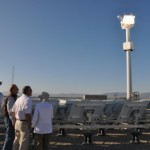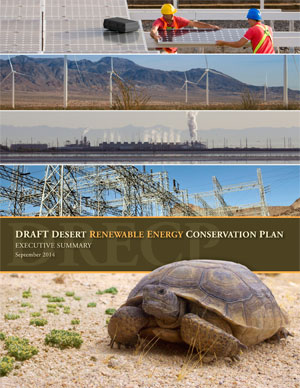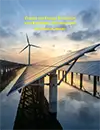
New Power Tower Technolgy being developed by eSolar in Lancaster, California
The breakthrough was announced at a press conference celebrating the signing of new state legislation SBX8 34 , a bill that will ensure state regulatory agencies have the resources necessary to focus on the state’s stringent environmental review process while still issuing permits for new renewable energy facilities.
The bill creates further efficiencies in the permitting and siting process for large-scale renewable energy projects that could qualify for federal stimulus funds. It creates a $10 million “Renewable Energy Resources Development Fee Trust Fund,” which will allow renewable developers to meet their California Endangered Species Act obligations without directly improving habitat for species.

Governor Scharzenegger signs new permit streamlining legislation as Interior Secretary Ken Salazar looks on.
“Our bold and innovative vision for California has made us a pioneer in renewable energy, green jobs and environmental protection and, as a result, we are seeing an energy revolution in California,” said Governor Schwarzenegger.
“California now has more than 240 proposed renewable projects looking to build and create jobs. Today’s action will help speed up the process for some of these large projects to break ground this year and qualify for federal stimulus funding. By working together, we can increase renewable energy development, create thousands of jobs and preserve our state’s cherished natural resources.”
Even before these pronouncements, the 392 MW Ivanpah Solar Electric Generating System developed by BrightSource Energy gained approval from the California Energy Commission (CEC) on March 17th. This CSP project — which deploys a new 459-foot tall “power towers” technology – would be the first new large scale solar thermal projects built in California in nearly two decades.
The CEC environmental impact review took two-and-a-half years, a comparatively short time considering that many largescale projects in the state have been involved in the permitting process for close to a decade. (Part of the urgency on behalf of the Ivanpah facility was a $1.37 billion loan guarantee from the federal Department of Energy that will expire if construction does not begin before the end of 2010.)
There are more than 240 proposed renewable energy projects in California that could produce nearly 70,000 MW of clean energy annually. These proposed projects throughout the state include solar, wind, geothermal, biomass and small hydro facilities. Nearly 50 of these proposed projects have indicated they will apply for Recovery Act funds. For those proposed projects looking for federal stimulus support, 21 could generate power at utility-sized levels of larger than 200 MW, totaling more than 9,000 MW. Currently, California facilities produce just over 8,000 MW of renewable energy annually.
Yet some more good news comes in the form of an early budget legislation package that offers additional support for new renewable energy developments in the form of new tax breaks. The exemption from sales taxes on manufacturing equipment granted to on green technologies — up to $100 million annually — is an albeit small breakthrough, but could encourage renewable parts and equipment to be manufactured in California.
Other signs of progress include an agreement between farmers and solar developers to cluster new renewable generation on lands precluded from agricultural activities due to past pollution problems and high levels of salinity. As environmental challenges mount in the desert, shortages of water, prior environmental damage, and fewer protected lands and species have made lower solar radiation central valley lands more attractive alternative sites for Big Solar.


